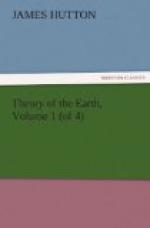As naturalists have explained all mineral concretions from aqueous or other solution, and attributed to infiltration the formation of those stony bodies in which there are marks of their original composition, so have they explained to themselves, I suppose, the origin of those bituminous bodies which are found among the strata of the earth. In the case of stony substances, I have shown how unfounded all their theories are for the production of those concretions, crystallizations, and consolidated bodies. I am here to examine the subject of inflammable and combustible bodies, which I believe have been little considered by those theorists who suppose mineral bodies consolidated by infiltration. It is here that we shall find an infinite difference between the aqueous and igneous theories; for, we shall find it impossible to explain by the one certain operations which must have necessarily required the great agent generally employed in the other.
The subject of this chapter is a touch-stone for every theory of the earth. In every quarter of this globe, perhaps in every extensive country, bituminous strata are to be found; they are alternated with those which are called aquiform, or which had been evidently formed by subsidence of certain moved materials at the bottom of the sea; so far, therefore, all those strata have had the same origin. In this point I think I may assert, that all the different theories at present are agreed; and it is only concerning certain transformations of those strata, since their original collection, that have been ascribed to different causes.
Of these transformations, which the strata must have undergone, there are two kinds; one in relation to change of place and position; the other in relation to solidity or consistence. It is only the last of those two changes which is here to be the subject of consideration; because, with regard to the first, there is nothing peculiar in these bituminous strata to throw any light, in that respect, upon the others. This is not the case with regard to the transformation in their chemical character and consistence; bituminous bodies may not be affected by chemical agents, such as fire and water, in the same manner as the argillaceous, siliceous, micaceous, and such other strata that are alternated with the bituminous; and thus we may find the means for investigating the nature of that agent by which those strata in general have been transformed in their substance; or we may find means for the detecting of false theories which may have been formed with regard to those operations in which the original deposits of water had been changed.




